- The Basics of Kniphofia Cultivation
- Introduction
- Selecting the Right Location
- Preparing the Soil
- Planting Kniphofia
- Watering and Care
- Fertilizing
- Dividing and Propagation
- Pest and Disease Control
- Conclusion
- Choosing the Right Location for Kniphofia
- Sunlight
- Soil
- Watering
- Space
- Protection
- Soil Requirements for Growing Kniphofia
- Well-Draining Soil
- Loamy Soil
- Organic Matter
- Sun Requirements
- Watering
- Fertilization
- Proper Watering Techniques for Kniphofia
- 1. Watering Frequency
- 2. Watering Method
- 3. Soil Moisture
- 4. Mulching
- 5. Watering During Winter
- 6. Additional Tips
- Fertilizing Kniphofia for Healthy Growth
- 1. Choose the Right Fertilizer
- 2. Apply Fertilizer in Spring
- 3. Avoid Over-Fertilization
- 4. Incorporate Organic Matter
- 5. Mulch Around the Plants
- 6. Monitor and Adjust
- Pruning and Deadheading Kniphofia
- Pruning
- Deadheading
- Protecting Kniphofia from Pests and Diseases
- Pests
- Diseases
- General Care
- Propagating Kniphofia through Division
- Step 1: Timing
- Step 2: Preparation
- Step 3: Digging up the plant
- Step 4: Division
- Step 5: Replanting
- Step 6: Watering and Mulching
- Step 7: Care and Maintenance
- Winter Care for Kniphofia Plants
- 1. Mulch
- 2. Watering
- 3. Pruning
- 4. Protection
- 5. Dividing
- Questions and Answers:
- What is Kniphofia?
- How do I plant Kniphofia?
- What care does Kniphofia require?
- Can I grow Kniphofia in a pot?
- How tall do Kniphofia plants get?
- What pests and diseases affect Kniphofia?
- Videos: Penstemon in Full Bloom: ‘Midnight Masquerade’!
Kniphofia, also known as red hot poker or torch lily, is a stunning and vibrant plant that can add a pop of color to any garden. Native to South Africa, these perennial flowers are known for their tall spikes of tubular flowers in shades of red, orange, and yellow. With their unique shape and eye-catching colors, kniphofias are a favorite among gardeners looking to create a focal point or add diversity to their flowerbeds.
When it comes to cultivating kniphofias, it’s important to choose a sunny spot in the garden with well-drained soil. These plants thrive in full sun and can tolerate drought conditions, making them ideal for arid or Mediterranean climates. Kniphofias can be planted in the spring or fall, and they typically reach their full height and bloom in the summer months.
Once established, kniphofias require minimal care. Regular watering during dry spells is recommended, but be careful not to over-water as this can cause the roots to rot. Deadheading the spent flowers will encourage new blooms and prolong the flowering season. In colder climates, it’s advisable to protect the kniphofia crowns with a layer of mulch to insulate them from frost.
Overall, kniphofias are a versatile and low-maintenance addition to any garden. Their vibrant colors and striking presence make them a popular choice for adding drama and visual interest. With the proper care and attention, kniphofias can provide years of enjoyment and beauty in the garden.
The Basics of Kniphofia Cultivation
Introduction
Kniphofia, also known as red hot poker or torch lily, is a stunning perennial that adds a splash of color to any garden. With its striking flower spikes and vibrant hues, it is sure to catch the eye of any passerby. Cultivating kniphofia requires a few key steps to ensure its success, including selecting the right location, preparing the soil, and providing proper care.
Selecting the Right Location
When choosing a location for your kniphofia, keep in mind that it prefers full sun to partial shade. It thrives in well-draining soil and can tolerate a range of soil types, including sandy or clay soils. However, it is important to avoid areas that are prone to waterlogging, as this can lead to root rot.
Preparing the Soil
Before planting your kniphofia, it is crucial to prepare the soil properly. Start by removing any weeds or grass from the area and loosen the soil with a garden fork or tiller. If the soil is heavy or compacted, incorporate organic matter such as compost or well-rotted manure to improve its drainage and fertility.
Planting Kniphofia
Once the soil is prepared, it’s time to plant your kniphofia. Dig a hole that is slightly larger than the root ball of the plant, ensuring that the crown is level with the ground. Backfill the hole with soil, gently firming it around the roots to eliminate any air pockets. Water the plant thoroughly after planting to settle the soil.
Watering and Care
Kniphofia requires regular watering to thrive, especially during dry periods. However, it is important to avoid overwatering, as this can lead to root rot. Allow the soil to dry slightly between waterings, and water deeply to encourage the development of a strong root system. Apply a layer of organic mulch around the base of the plant to help retain moisture and suppress weeds.
Fertilizing
To promote healthy growth and abundant blooms, fertilize your kniphofia annually in the spring. Use a balanced slow-release fertilizer or a top dressing of well-rotted compost. Avoid overfertilizing, as this can cause the plant to produce excessive foliage at the expense of flowers.
Dividing and Propagation
Kniphofia can be divided every few years in the spring or fall to control its size and rejuvenate the plant. Dig up the clump, separate the individual plants, and replant them in well-prepared soil. Propagation can also be done through seeds or by taking stem cuttings. However, keep in mind that division and cuttings are the most reliable methods for maintaining the characteristics of the parent plant.
Pest and Disease Control
Kniphofia is generally disease-resistant, but it may occasionally be prone to aphid infestations. These pests can be controlled through the use of insecticidal soap or by attracting natural predators such as ladybugs. Regular inspection and prompt action can help prevent the spread of any potential diseases or pests.
Conclusion
With its vibrant flowers and easy-care nature, Kniphofia is a great addition to any garden. By selecting the right location, preparing the soil, and providing proper care, you can enjoy the beauty of this stunning perennial for years to come.
Choosing the Right Location for Kniphofia
When it comes to growing Kniphofia, also known as red hot pokers or torch lilies, choosing the right location is key to ensuring their health and successful growth. Kniphofias are native to southern Africa and thrive in warm, sunny environments. Here are some factors to consider when selecting the perfect spot for your Kniphofia:
Sunlight
Kniphofias require full sun to thrive. Make sure to choose a location that receives at least 6 hours of direct sunlight per day. Avoid planting them in shaded areas, as lack of sunlight can result in weak growth and fewer blooms.
Soil
Kniphofias prefer well-draining soil with a slightly acidic to neutral pH. They don’t tolerate heavy clay soils or waterlogged conditions, as this can lead to root rot. If your soil is heavy and clay-like, consider amending it with organic matter to improve drainage.
Watering
While Kniphofias prefer well-drained soil, they still require regular watering, especially during dry periods. Make sure the location you choose has easy access to water so you can provide consistent moisture to the plants. However, be careful not to overwater them, as this can also be detrimental to their health.
Space
Kniphofias are clump-forming perennials that can spread over time. When choosing a location, make sure to provide enough space for them to grow without overcrowding other plants nearby. This will also allow good air circulation, which can help prevent diseases.
Protection
Consider the surrounding landscape and choose a location that provides some protection from strong winds. Kniphofias have tall flower spikes that can be vulnerable to wind damage. Planting them near a natural windbreak, such as a wall or trees, can help prevent breakage and keep the plants upright.
By considering these factors and choosing the right location for your Kniphofia, you can ensure that these beautiful plants thrive in your garden and provide months of vibrant color and interest.
Soil Requirements for Growing Kniphofia
Kniphofia, also known as red hot poker or torch lily, is a flowering plant that belongs to the Asphodelaceae family. To ensure successful cultivation and growth of kniphofia in your garden, it is important to provide the right soil conditions.
Well-Draining Soil
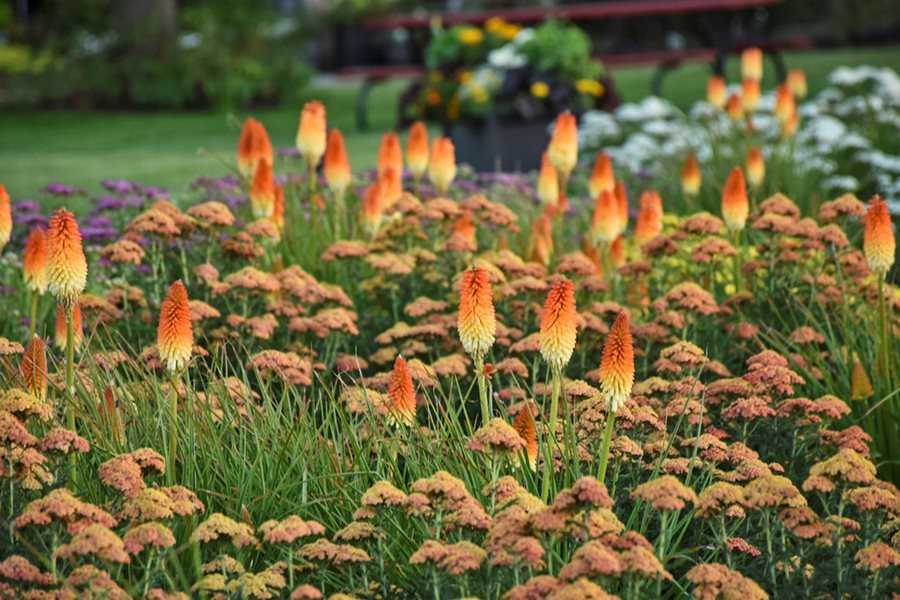
Kniphofia prefers well-draining soil that allows water to pass through easily. It does not thrive in heavy clay or waterlogged soil. To improve drainage, you can amend the soil with organic matter such as compost or well-rotted manure.
Loamy Soil
An ideal soil type for kniphofia is loamy soil. Loam is a balanced mixture of sand, silt, and clay, which provides good structure and nutrient retention. It allows for proper aeration and root development.
Kniphofia grows best in slightly acidic to neutral soil, with a pH range between 6.0 and 7.0. It is important to test your soil’s pH level and make necessary adjustments if needed. You can use soil testing kits or consult with a local agricultural extension office for guidance.
Organic Matter
Adding organic matter such as compost or well-rotted manure to the soil improves its structure, fertility, and moisture-holding capacity. This helps to create a favorable environment for kniphofia plants to grow and thrive.
Sun Requirements
Kniphofia plants require full sun to bloom and grow properly. They need at least 6-8 hours of direct sunlight per day. Choose a sunny spot in your garden that receives ample sunlight throughout the day.
Watering
While kniphofia plants are relatively drought-tolerant once established, they still require regular watering, especially during dry periods. Water deeply and thoroughly, allowing the soil to dry out slightly between waterings. Avoid overwatering as it can lead to root rot.
Fertilization
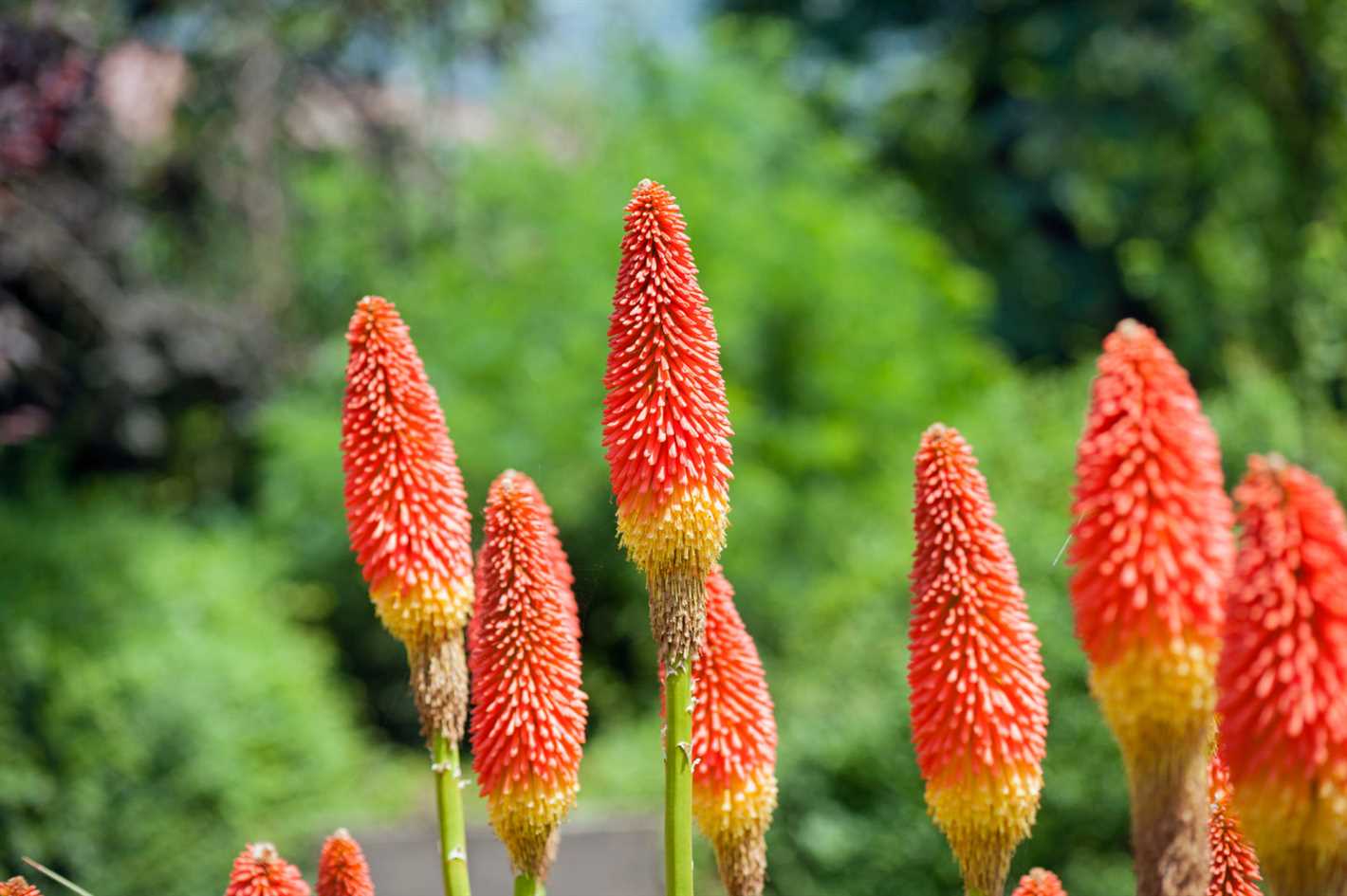
Kniphofia plants benefit from regular fertilization to promote healthy growth and flowering. Apply a balanced, slow-release fertilizer in the spring or use a liquid fertilizer every few weeks during the growing season, following the manufacturer’s instructions.
By providing the right soil conditions, you can ensure that your kniphofia plants thrive and produce stunning blooms in your garden.
Proper Watering Techniques for Kniphofia
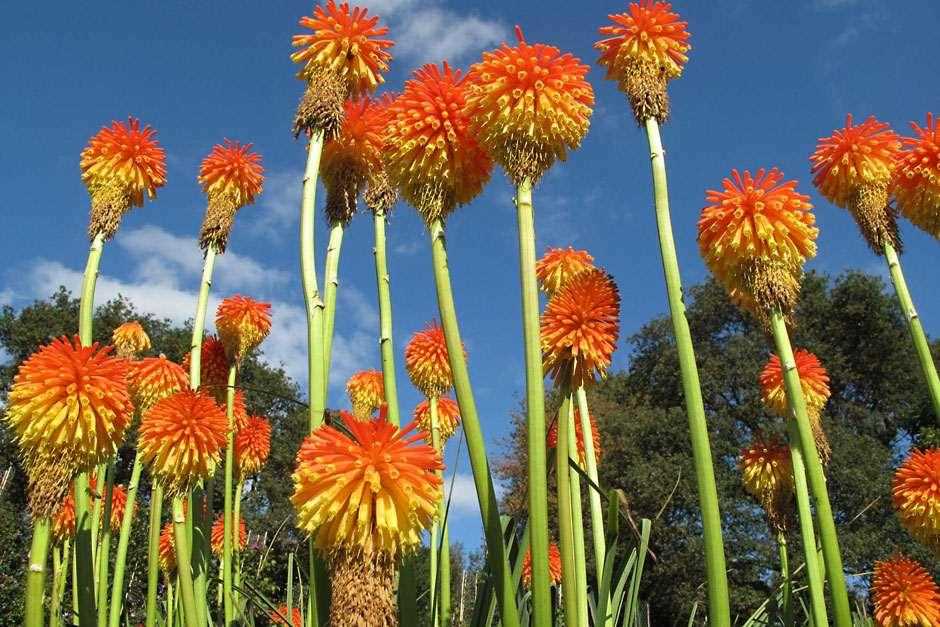
Proper watering is essential for the health and vitality of Kniphofia plants. These beautiful flowering perennials, also known as torch lilies or red hot pokers, require a specific watering routine to thrive in the garden.
1. Watering Frequency
- Kniphofia plants should be watered deeply but infrequently.
- Water the plants once every week or two, depending on the weather and soil conditions.
- During dry spells or in sandy soil, more frequent watering may be necessary.
2. Watering Method
- Water the base of the plant, avoiding overhead watering.
- Use a watering can or a soaker hose to deliver water directly to the root zone.
- Avoid wetting the foliage, as this can lead to fungal diseases.
3. Soil Moisture
- Before watering, check the soil moisture level to avoid overwatering.
- Stick your finger about an inch into the soil. If it feels dry at this depth, it’s time to water.
- Avoid letting the soil become overly saturated, which can lead to root rot.
4. Mulching
- Apply a layer of organic mulch around the base of the Kniphofia plants.
- Mulching helps retain soil moisture and helps regulate soil temperature.
- Choose mulch materials such as wood chips or compost.
5. Watering During Winter
- In winter, Kniphofia plants go dormant and require less water.
- Reduce watering frequency to once every 3-4 weeks.
- Ensure that the plant receives enough water to prevent dehydration.
6. Additional Tips
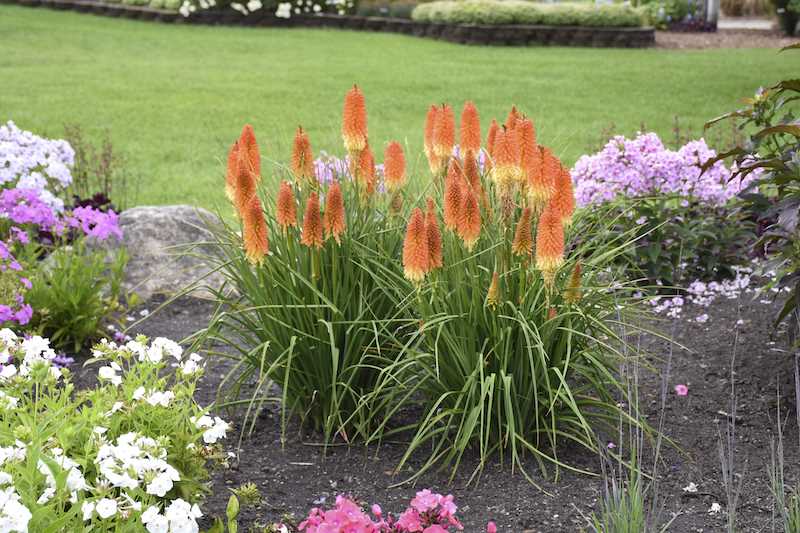
- Consider using a rain gauge or a moisture meter to monitor soil moisture levels.
- Water early in the day to allow foliage to dry before nightfall, preventing disease.
- Adjust the watering routine based on the specific needs of your Kniphofia variety and local climate.
By following these proper watering techniques, you can ensure that your Kniphofia plants thrive and produce beautiful, vibrant blooms.
Fertilizing Kniphofia for Healthy Growth
Kniphofia, commonly known as “red hot poker” or “torch lily,” is a stunning perennial plant that adds vibrant color to any garden. To ensure healthy growth and abundant blooms, it’s important to provide proper fertilization. Here are some tips on fertilizing Kniphofia:
1. Choose the Right Fertilizer
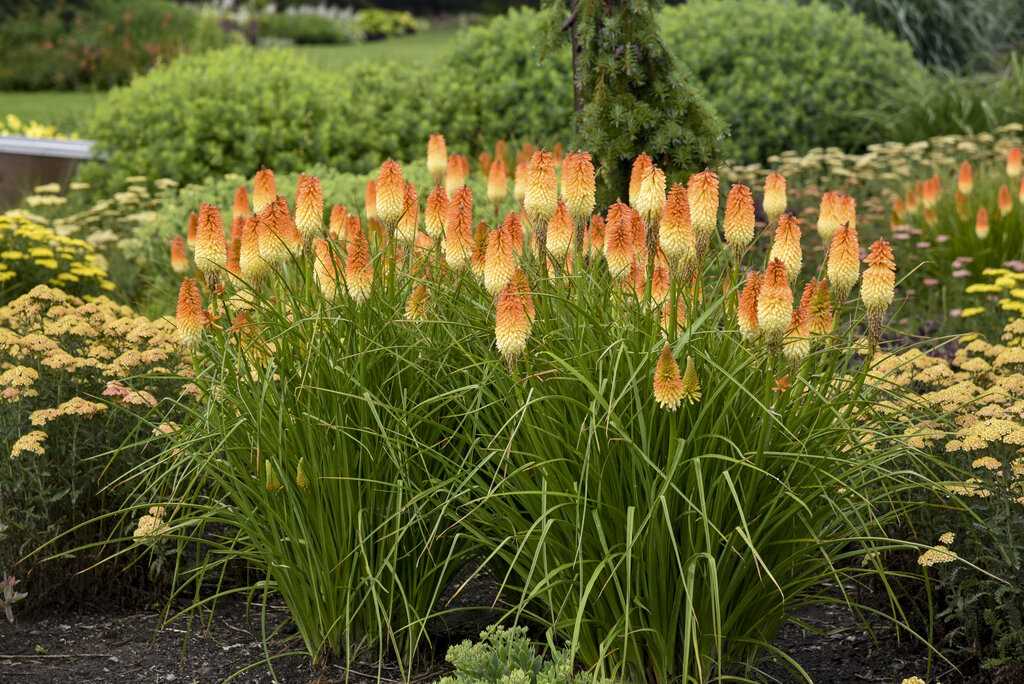
Kniphofia plants benefit from a balanced fertilizer that is rich in nitrogen, phosphorus, and potassium (NPK). Look for a fertilizer with an NPK ratio of around 10-10-10 or 14-14-14. This will provide the necessary nutrients for healthy growth and flower production.
2. Apply Fertilizer in Spring
Apply the fertilizer in early spring, just as new growth begins to emerge. This will give the plants a boost of nutrients when they need it most. Follow the package instructions for the recommended amount of fertilizer to use.
3. Avoid Over-Fertilization
While Kniphofia plants benefit from regular fertilization, it’s important not to overdo it. Excessive fertilizer can lead to lush foliage but fewer blooms. Follow the recommended dosage on the fertilizer package and avoid applying too much fertilizer at one time.
4. Incorporate Organic Matter
In addition to using a balanced fertilizer, incorporating organic matter into the soil can also benefit Kniphofia plants. Organic matter, such as compost or well-rotted manure, improves soil structure, fertility, and moisture retention.
5. Mulch Around the Plants
Applying a layer of organic mulch around the base of Kniphofia plants can help retain moisture, control weeds, and provide slow-release nutrients as it breaks down. Use a 2-3 inch layer of mulch, such as wood chips or straw, and keep the mulch a few inches away from the stems to prevent rot.
6. Monitor and Adjust
Monitor the growth and health of your Kniphofia plants throughout the growing season. If you notice signs of nutrient deficiency, such as yellowing leaves or poor growth, you may need to adjust your fertilization routine. Consider getting a soil test to identify any specific nutrient deficiencies that need addressing.
By following these fertilization tips, you can ensure that your Kniphofia plants are well-nourished and thrive in your garden, providing you with beautiful blooms year after year.
Pruning and Deadheading Kniphofia
Pruning and deadheading are important tasks in maintaining the health and appearance of your kniphofia plants. Proper pruning techniques will help to promote new growth, control the size of the plant, and remove any dead or diseased foliage.
Here are some guidelines for pruning and deadheading your kniphofia:
Pruning
- Pruning should be done in early spring before the new growth begins.
- Start by removing any dead or damaged leaves. This will help to prevent the spread of disease and also improve the appearance of the plant.
- Next, cut back any old or faded flowers to encourage new growth and prolong the blooming period.
- If the plant has become too large or is overcrowding other plants, you can also trim back the foliage to control its size.
- Make sure to use sharp, clean pruning shears to make clean cuts and avoid introducing any diseases.
Deadheading
- Deadheading is the process of removing spent flowers to promote continued blooming.
- As soon as a flower has finished blooming and begins to fade, use your fingers or a pair of scissors to remove the flower stalk at its base.
- This will redirect the plant’s energy towards producing new blooms rather than setting seeds.
- Deadheading should be done regularly throughout the blooming season to ensure a continuous display of flowers.
By following these pruning and deadheading techniques, you can help to keep your kniphofia plants healthy and blooming their best throughout the growing season.
Protecting Kniphofia from Pests and Diseases
Like other plants, Kniphofia can be susceptible to pests and diseases. However, with proper care and attention, you can protect your Kniphofia from these issues and keep them healthy and vibrant in your garden.
Pests
- Aphids: These small, soft-bodied insects can be found on the leaves and stems of Kniphofia. They suck the sap from the plant, causing the leaves to curl and distort. You can control aphids by spraying the plant with a strong stream of water or using insecticidal soap.
- Spider mites: These tiny pests often go unnoticed until their damage becomes visible. They feed on the plant’s sap and leave behind small, yellow specks on the leaves. To control spider mites, regularly inspect your Kniphofia for signs of infestation and use insecticidal soap or neem oil if necessary.
- Slugs and snails: These slimy pests can chew holes in the leaves and flowers of Kniphofia. To protect your plants, you can handpick slugs and snails or use organic slug pellets around the base of the plant.
Diseases
- Leaf spot: This fungal disease causes dark spots to appear on the leaves of Kniphofia. To prevent leaf spot, avoid overhead watering and provide good air circulation around the plants. If leaf spot occurs, remove and destroy the affected leaves.
- Crown rot: This disease is caused by a fungus that attacks the base of the plant, leading to rotting and wilting. To prevent crown rot, avoid overwatering and ensure good drainage around the plants. If crown rot occurs, remove and destroy the infected plants.
- Rust: This fungal disease appears as orange or rusty-colored spots on the leaves. It can be controlled by removing and destroying the affected leaves and using a fungicide if necessary.
General Care
In addition to protecting your Kniphofia from pests and diseases, regular care practices can help keep them healthy:
- Water the plants deeply and regularly, especially during dry periods.
- Apply a layer of mulch around the base of the plants to conserve moisture and suppress weed growth.
- Divide overcrowded clumps every few years to maintain plant health and vigor.
- Remove faded flowers to encourage continuous blooming.
By taking these steps to protect your Kniphofia from pests and diseases and providing them with proper care, you can enjoy their beautiful blooms and vibrant colors in your garden for years to come.
Propagating Kniphofia through Division
Kniphofia, also known as red hot poker or torch lily, can be propagated through division. This method involves separating the clumps of the plant into smaller sections, each with its own roots and shoots. Here’s how to do it:
Step 1: Timing
The best time to divide kniphofia is in early spring, before new growth starts. This gives the divisions enough time to establish themselves before the heat of summer.
Step 2: Preparation
Start by preparing the new planting locations for the divisions. Make sure the soil is well-draining and amend it with compost or organic matter if needed.
Step 3: Digging up the plant
Using a garden fork or shovel, carefully dig up the entire clump of kniphofia. Try to avoid damaging the roots as much as possible.
Step 4: Division
Once the clump is out of the ground, use a sharp knife or garden shears to divide it into smaller sections. Each division should have at least three or four shoots and a healthy root system.
Step 5: Replanting
Plant each division in its new location, making sure the crown of the plant is at or slightly above ground level. Space the divisions about 12 to 18 inches apart to allow for future growth.
Step 6: Watering and Mulching
After replanting, water the divisions thoroughly to help them settle in and remove any air pockets around the roots. Apply a layer of mulch around the plants to conserve moisture and suppress weed growth.
Step 7: Care and Maintenance
Continue to care for the newly divided kniphofia by watering regularly, especially during dry spells, and providing a balanced fertilizer. Remove any dead or wilted foliage to keep the plants healthy and attractive.
With proper care, the divided kniphofia should establish themselves and start producing new growth within a few weeks. They will eventually grow into mature plants and reward you with their vibrant flowers.
Winter Care for Kniphofia Plants
Kniphofia, also known as red hot pokers, are flowering plants that add a vibrant touch to any garden. While they are generally hardy and can withstand some cold temperatures, it is important to provide proper winter care to ensure their survival and health. Here are some tips for caring for your kniphofia plants during the winter months:
1. Mulch
Adding a layer of mulch around the base of your kniphofia plants can provide insulation and protect them from freezing temperatures. Use a layer of mulch about 2-3 inches deep, making sure to keep it away from the crown of the plant to prevent rot.
2. Watering
During the winter, kniphofia plants require less water than during the growing season. However, it is important to monitor the moisture levels in the soil and water them if it becomes dry. Be careful not to overwater, as this can lead to root rot.
3. Pruning
In late fall or early winter, trim back any dead or damaged foliage from your kniphofia plants. This will help prevent disease and pest infestations during the winter months. However, avoid cutting back the entire plant, as the remaining foliage can provide some protection from the cold.
4. Protection
If you live in an area with harsh winters, you may need to provide additional protection for your kniphofia plants. You can use burlap or a frost blanket to cover the plants during cold spells, especially if temperatures drop below freezing for an extended period.
5. Dividing
Winter is a good time to divide your kniphofia plants if they have become overcrowded. Dig up the clump and carefully separate the individual plants, making sure to keep a good portion of roots attached to each division. Replant the divisions in well-drained soil and water thoroughly.
By following these winter care tips, you can ensure that your kniphofia plants survive the cold months and come back strong in the spring. Enjoy their vibrant blooms year after year!
Questions and Answers:
What is Kniphofia?
Kniphofia, also known as red-hot poker, torch lily or poker plant, is a genus of flowering plants native to Africa. They are known for their tall spikes of tubular flowers in shades of red, orange, and yellow.
How do I plant Kniphofia?
To plant Kniphofia, choose a location that receives full sun and has well-drained soil. Dig a hole slightly larger than the root ball of the plant and place the Kniphofia in the hole. Backfill with soil and water thoroughly. Space individual plants about 2 to 3 feet apart.
What care does Kniphofia require?
Kniphofia requires regular watering, especially during dry spells, to keep the soil consistently moist. Deadhead faded flowers to encourage more blooms. In colder climates, it is recommended to mulch around the base of the plant in winter to protect it from frost.
Can I grow Kniphofia in a pot?
Yes, Kniphofia can be grown in a pot as long as the pot has good drainage and is large enough to accommodate the plant’s root system. Use a well-draining potting mix and water regularly to keep the soil moist but not waterlogged.
How tall do Kniphofia plants get?
The height of Kniphofia plants can vary depending on the variety, but most grow between 2 to 6 feet tall. The flower spikes can reach up to 4 feet in height. It is important to choose a variety that suits the desired height for your garden.
What pests and diseases affect Kniphofia?
Kniphofia is generally resistant to pests and diseases, but it can be occasionally affected by aphids or spider mites. These can be controlled with insecticidal soap or by spraying the plants with water to dislodge the pests. Rotting of the crown can occur in poorly drained soil, so it is important to ensure the soil has good drainage.







